Between the years 1906 and 1910, pioneering Harry Macphearson laboured long and hard amongst the Scottish Grampian highlands to create the first photographic record of breeding Golden Eagles in Scotland. Now Terry Pickford recounts the exploits of this unsung Highland warrior from a past era.
“In a wild deer-forest in the heart of the Grampian range, there lies a dark gloomy corrie, where the sun penetrates for but a few short hours during the long summer’s day. At the head of the gorge where the rocks rise almost perpendicularly from the banks of a brawling burn, a pair of Golden Eagles had first made their eyrie in by-gone days.”
Written over a century ago by the Scottish Naturalist H.B.Macpherson these words, appeared as an introductory text, in the first photographic study of the Golden Eagle to be published in Britain.
The book was titled “The Home Life of the Golden Eagle” and contained within its 78 pages, 32 individually hand-mounted black and white plates. Harry Macpherson’s endeavours established a testimony to one man’s pioneering photographic abilities within the Highlands of Scotland.
Without doubt Macpherson’s early photographic work with eagles, undertaken during the hey-days of the British Raj in India, recorded for future posterity a period of significant importance in Scottish heritage. His labours and photographic capabilities set an initiative then, fostering trends in eagle photography for many others of the same ilk to admire and follow in years to come.
The standard of Macpherson’s field work carried out under extreme hardships a century ago was a most extraordinary undertaking. Travelling by push bike and on foot, he transported heavy wooden plate cameras to those remote nesting corries.
Each expedition undertaken involved a daily round trip from his home of fifty miles, demonstrating the level of Macpherson’s dedication. When one considers that Macpherson, using old drovers’ tracks in those days to make his journeys, travelling some 1000 miles cycling alone, his achievement was nothing less than remarkable. These laborious field trips often resulting in soakings and many long hours in damp and cold photographic hides, contributed to an illness and Mcpherson’s subsequent death in 1947.
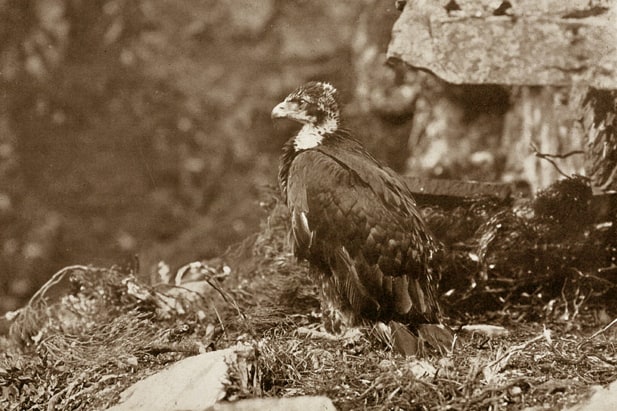
From the pages of ‘The Home Life of the Golden Eagle’ the reader is reminded of the many logistical and technological handicaps faced by Harry Macpherson. The laborious transportation by cycle of bulky and heavy camera accessories, hide materials and food, were all fundamental difficulties that he successfully overcame. Such a challenge would have defeated lesser mortals faced with similar circumstances. Macpherson’s eagle portraits, while lacking the crisp sharpness made possible by modern optics and digital technology available today, convey a strong sense of atmosphere and nostalgia. By reading his book and viewing the mounted sepia coloured plates, they transport the imagination backwards in time to an era of which we were never a part.
Regrettably few copies of ‘The Home Life of the Golden Eagle’ have survived. Several copies of this now rare manuscript have been preserved intact by private individuals. Unfortunately the only copy of the book available to the public (in very poor condition), is retained by the Inverness public library. Anyone wishing to read the book can do so under supervision by arrangement there.

From the limited technical information recorded in Macpherson’s book, typically daylight exposures varied between 1/12th and 1/45th sec at f8. This factor above any other limited his photographic scope at the eyrie.
Traditionally most Golden Eagle eyries face north, so sunlight upon the eyrie could never be guaranteed. Just after dawn when feeding activity within the eyrie is prominent, or during periods of harsh weather, exposures of ten seconds at f8 were made by Macpherson.
Speaking from personal experience, poor light remains a fundamental problem encountered by any eagle photographer, though modern photographic technology has overcome most of the difficulties encountered by Macpherson. Action photography and the use of a fast lens, electronic flash and a fast ISO speed, were options not available to Macpherson, the bulk of his exposures being obtained during periods when he knew the nesting birds were standing motionless or had fallen asleep.
In his early pioneering experiments to secure photographic portraits of nesting Golden Eagles, Macpherson would simply secure his wooden plate camera to overlook the nest. Firmly secured beneath boulders and camouflaged with heather, the lens poking out towards the large stick structure would be pre focused upon the eyrie.
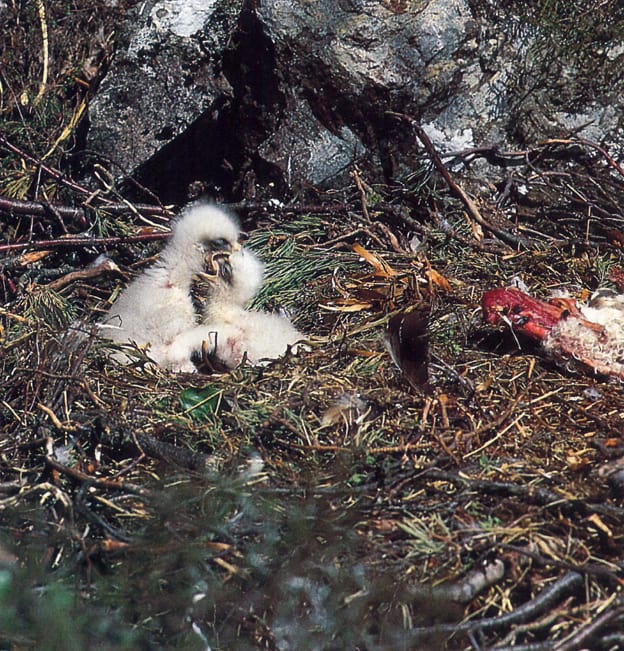
A long length of rubber tube connected to an air bulb was attached to the camera’s shutter release. The tube was draped around the nesting ledge corner with the bulb laid out of sight from the eyrie. Using a good telescope, positioned at a suitable vantage position often a mile away from the eyrie. Macpherson would then wait the reappearance of the Golden Eagle before returning stealthily towards the eyrie to press the bulb securing the single image.
To his personal credit, the safety and well-being of an eyrie was an important criteria. Photography only proceeded after the eggs within the nest had hatched during the lengthy 48 days of egg incubation, nesting eagles subjected to frequent human disturbance are prone to desertion.
In order to reduce disturbance even more Macpherson concluded that he could only make one, or perhaps two, exposures per day using this time consuming method. As his experience progressed, along with the location of more accessible eyries to photograph, several hides were built in co-operation with estate stalkers. By using two cameras fitted with lenses of varied focal lengths within the hide, he was able to secure many more exposures per day.
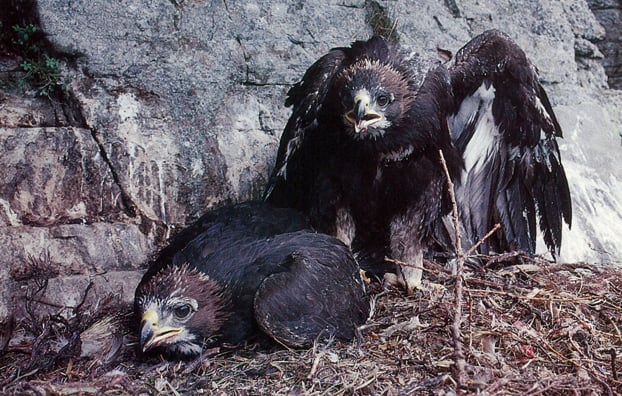
In the late 1980′s the stalker working on the same deer forest estate frequented by Macpherson over eight decades earlier, discovered by chance the tattered remnants of the photographer’s old canvas hides. The debris had been blown from the nesting cliff into the corrie bottom by countless winter storms that has occurred within the nesting glen since that period.
In 1990 at the invitation of the estate, I was most fortunate and privileged to have been invited to visit the forest retracing those early steps taken by Macpherson. An exciting aspect of my visit into this remote Highland deer forest, was a discovery that eyries visited and photographed by Macpherson just after the turn of the 20th century were still tenanted by breeding Golden Eagles. Just as important, occupied eyries established within this forest were still afforded full protection by the present estate owner and his stalking staff. Two eaglets successfully produced in 1990,1991 and in 1992, making six fledged eaglets in just three season, a remarkable achievement.
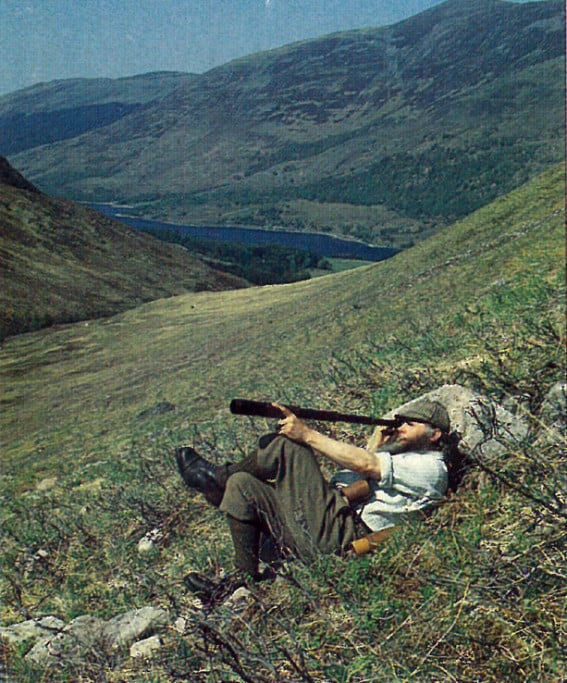
As I traversed the breeding glen for the last time in the summer of 1992, two large eaglets could clearly be seen standing sentinel on the very edge of their now flatted eyrie.
Aided by a strong updraft from the corrie below, both eaglets flexed their outstretched wings as a prelude to fledging from their rocky abode high above the brawling burn. Sitting for a few moments among the strewn boulders that July evening, I couldn’t help wondering how may generations of eaglets had been reared within this nesting glen in the intermediate years following Harry Macpherson’s last visit into this remote Highland region?
Terry Pickford.
Footnote:
Golden Eagle Prejudice is still very much alive in Scotland, but it is difficult to justify or accept such narrow-mindedness and outdated victorian attitudes especially from an MSP at the heart of the Scottish government.
The protection of Golden Eagles and other iconic Scottish raptors are embroiled in what can only be described as a disgraceful political football game. Last week a White-tailed eagle poll inScotlanddemonstrated that of those people who voted 92% believed thatScotland’s White-tailed eagles should not be controlled.
This week MSP members of the Public Petitions Committee considered a call to make the golden eagle the national bird ofScotland, a very laudable proposal mostintelligentpeople would agree with. You would be wrong, once again politics and outdated prejudicial sentiments rather than rational thinking and common sense attempted to high jacked the debate.
Jackson Carlaw aTory politician challenged the proposals because he felt the golden eagle demonstrated a negative imperial association. Carlaw pointed out to the committee an eagle symbol was used with a swastika by the Nazis, as well as by the Roman legions. Carlaw went on to say “the depiction of the bird will have been the last thing some people saw before being “marched to their deaths.”
What the Tory MSP failed to explain to committee members was that an eagle symbol is still used today with pride as a national emblem by many European countries together with the United States of America and Mexico. Not because of any association with the Nazis or their misguided ideologies, but because of the birds courage, ferocity, strength, boldness and beauty, as well as being one of the most powerful and impressive predators in the world.
Carlaw’s outdated and ridiculous comments will have caused upset to many countries who have adopted the eagle as a national emblem, and additionally associating the eagle emblem with the Nazis will have also embarrassed the Scottish government at the same time.
We wish to point out to Mr Carlaw, a high proportion of the millions of visitors who visit Scotland, time and time again, are eager to see a golden eagle. For many this aspiration will never becomes a reality. The fortunate one’s whose dream are realised, do not associate the golden eagle with the Nazis, instead they appreciate the sight of such an iconic avian raptor with that makes Scotland’s landscape so beautiful, wild and inspiring.
My advise to you Mr Carlaw is, get a life and be grateful for huge benefits Scotland’s wildlife has to offer and for the millions of pounds spent by people who chose to visit your country to admire the fauna and flora that makes Scotland so great.
Terry Pickford
Throughout the last 47 years I have been involved in the conservation and protection of some of England’s rarest birds of prey. In 1967, in joint cooperation with the RSPB, the Nature Conservancy, now English Nature, I became a founder member of England’s first Raptor Study and Protection Group (The North West Raptor Group). Since 1974 my field work with raptors has been licensed by English Nature. I was a member of the UK Government Raptor Working Group which sat from 1995 to 2000. I am a qualified BTO licensed ‘A’ ringer permitting me to ring a variety of protected birds of prey at their nesting sites, including Golden Eagle (Scotland), Osprey, Red Kite, Goshawk, Peregrine Falcon and Barn Owl (England.) Between the years 1966 - 1976 I worked primarily throughout Speyside under the direction of the Hon. Douglas Weir (RSPB) where my work involved monitoring both the Golden Eagle and Peregrine Falcon populations in the Speyside area. In 1977 my work returned to England, where I began to monitor Peregrine nesting activity in both the Lake District National Park and the Forest of Bowland in Lancashire. During the past 40 years my activities associated with the peregrine falcon have been featured in several television documentaries. In 1986 my conservation work was featured in Central Televisions’ Nature Watch series hosted by Julian Petiffer. In the early 1980’s I was also involved in the reintroduction of the Peregrine Falcon (taken under licence from Scotland by a member of SNH), together with other falcons propagated in captivity back into the natural environment inside the Czech Republic, subsequently bringing about the recolonisation of peregrines in that country. In 1999 I decided to concentrate full time presenting wildlife illustrated lectures dealing specifically with raptors, their environment and protection. In 2002 at the invitation of the Polish Sea Eagle Conservation Committee, I became one of only a small handful of photographers permitted to photograph the White-tailed Sea Eagle inside Poland’s Sierakow Forest where I had been issued with the appropriate licence. The project lasted for 7 years until 2008. In the summers of 2011 and 2012 I returned to Scotland where I worked under a Scientific licence issued by Scottish Natural Heritage and the BTO to monitor and ring Golden Eagle in the Highland region. Most of this field work has been concentrated in the Blackmount and Glen Coe areas.


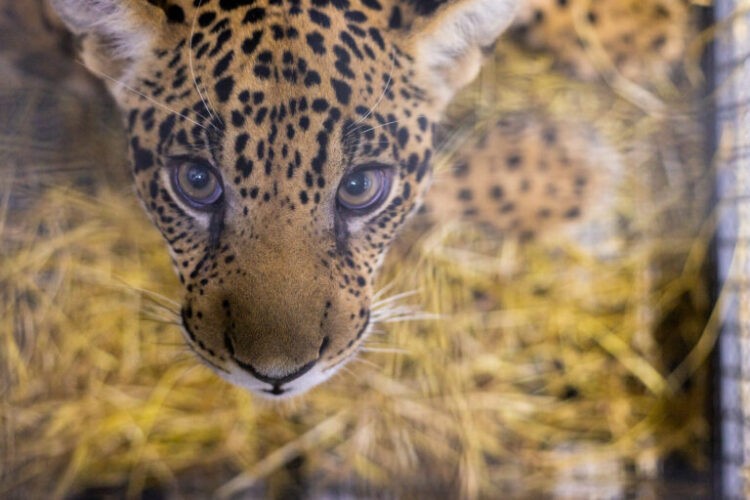




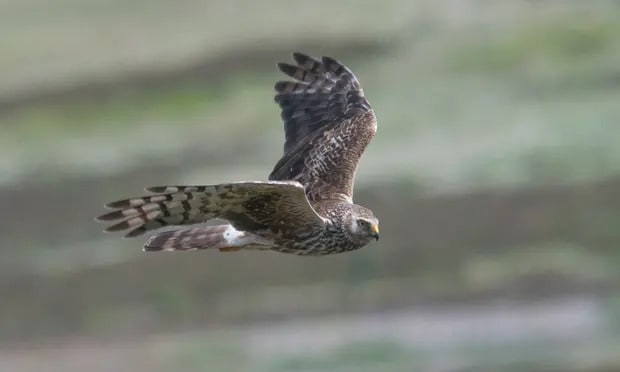
Leave a Reply